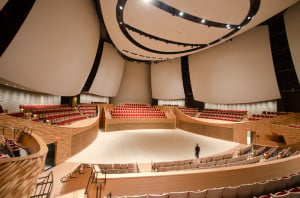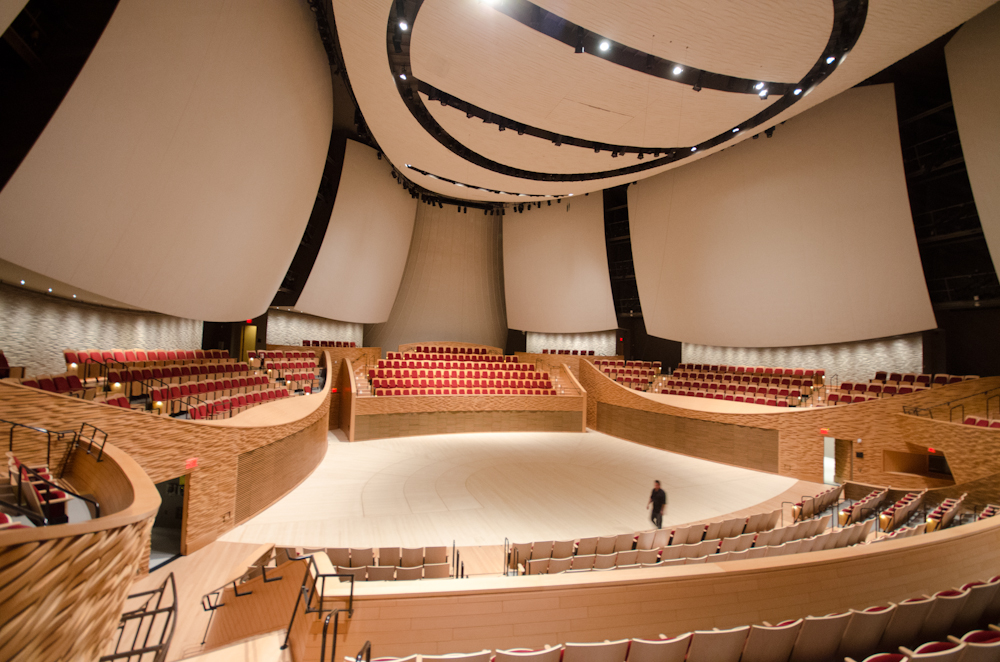For most concert halls and art programs today, a sold-out venue and consistently high-demand performances would be a dream come true. For Stanford Live, however, managing the excess demand for tickets at the newly opened Bing Concert Hall has been one of the greatest challenges this year, forcing the box office to rescind the tickets of several hundred patrons.

“The hall is so beautiful and the sound is so wonderful that there is so much excitement about it,” said Wiley Hausam, the executive director of Bing Concert Hall and Stanford Live. “And so, shows that wouldn’t have sold out before are selling out now.”
Bing Concert Hall, which opened on Jan. 11, 2013, has a seating capacity of 842. The new facility now allows Stanford to host orchestras and famous performers such as Itzhak Perlman and the Young Virtuosos of the Perlman Music Program, who performed on Sunday, Sept. 22. Twenty of the performances for the 2013-14 year are already sold out, largely due to the successful subscription campaign that ran during this summer.
In fact, demand for tickets was more than what Stanford Live was prepared for and actually exceeded the audience space. Hausam said that 300 more households ordered tickets than seats available, forcing Stanford Live to go through what Hausam described as “a very careful ticketing process” to determine who would get tickets and who would be left out.
“The situation here is so unusual—I haven’t heard about this much demand for tickets on subscription in 25 years,” Hausam said. “This never happens. That’s why we weren’t expecting it.
According to Hausam, Stanford Live allocates tickets through the same process that almost all arts and cultures organizations use. Donors are seated first based on the size of their donations to Stanford Live and Bing, and then the remaining subscribers are seated based on how long they have been attending performances and their history with the organization.
“The people who never subscribed before and had never given a donation before would have the least chance of getting in,” Hausam explained.
As a result, Stanford Live contacted those patrons who were denied the tickets they had initially purchased and offered them tickets to other performances, reservations for the Live Simulcast of San Francisco Opera’s Falstaff in Frost Amphitheater on Oct. 11 and other perks such as parking passes.
“Except for five or six or seven of them, they seemed to be happy by the end of our working with them to solve it,” Hausam said. “People, especially when it’s someone like Itzhak Perlman or Joshua Bell [performing], are very disappointed when they can’t get in.”
Local resident Barbara Wolf and Stanford professor Edwin Colloff were two ticket purchasers who were disappointed with the process.
Wolf had purchased tickets on June 3—the very start of the subscription campaign—for her and her husband to attend three different concerts, including Joshua Bell’s performance on Feb. 8, 2014.
“I have been wanting to see a Joshua Bell concert for three or four years now, but every time I’ve tried to see him his concerts have been sold out,” Wolf said. “I was thrilled when I was able to get the tickets.”
In early September, Stanford Live notified Wolf that she no longer had tickets to the Joshua Bell concert. She was also informed of the seating process that Stanford Live was using.
“When I heard that it just blew my mind,” Wolf said. “I said, ‘What am I, chopped liver? You are going to tell me that after you sold me these tickets that you are going to take them away from us because we didn’t make a charitable donation to Stanford?’”
Wolf, who has been attending concerts with her husband all over the Bay Area — and particularly at Stanford — for over 50 years, was determined to get her seats. After many phone calls and emails to Stanford Live, Wolf said the organization ultimately came through and gave her tickets.
Colloff encountered a similar situation. After purchasing a subscription on June 4, he was informed nearly three months later that his seating for the Haifa Symphony Orchestra could not be accommodated. The following week, he was told that he no longer had tickets.
After attempting to reaching Stanford Live several times, Colloff said he got in touch with Stanford Live’s Director of Marketing, Communications and Patron Services, Nancy Louise Bertossa, who eventually gave him seats to the Haifa Symphony.
“Managing the scarcity of seats has been one of our biggest challenges,” Hausam said. “It turns out that the demand for tickets for many of the shows is much greater than 842 seats. What we have to do is carefully manage the seats so particularly students have an opportunity to get in, in the way that is most convenient for them.”
That mindset is part of Stanford Live’s new emphasis on serving students. Hausam explained that Stanford Live hopes to have student attendance constitute 20 percent or more of the audience for all performances.
Although the Stanford Live website lists 20 performances where “tickets are currently not available,” Hausam explained that there are still student tickets available for these concerts. For example, the performances of Mariza, Deborah Voigt and the San Francisco Boys Chorus still have over 100 seats left for students to purchase. The Joshua Bell concert is completely sold out to the public and students, but the Haifa Symphony Orchestra had 16 student tickets available as of late last week. Student tickets are all $10, and each student is allowed to purchase two tickets per show.
“We really tried to hold the line on the number of student seats we were holding,” Hausam said. “I guess the easy way out would have been for us to just take the student seats and sell them to those people. But we didn’t do that.”
Stanford Live is also working to make unsold student tickets available a few days before the performance and at curtain time. According to Hausam, no-show rates are particularly high among students.
In order to avoid the overbooking next year, Stanford Live plans to roll out the subscription in phases. Current subscribers and current donors will have a private period to renew before Stanford Live will be available to the general public for subscriptions.
“The subscription period was announced to go through July 24, so we really couldn’t really do anything about it until after that point,” Hausam said. “It will not happen again. I can guarantee it.”
Contact Lucy Svoboda at lsvoboda ‘at’ stanford.edu.
